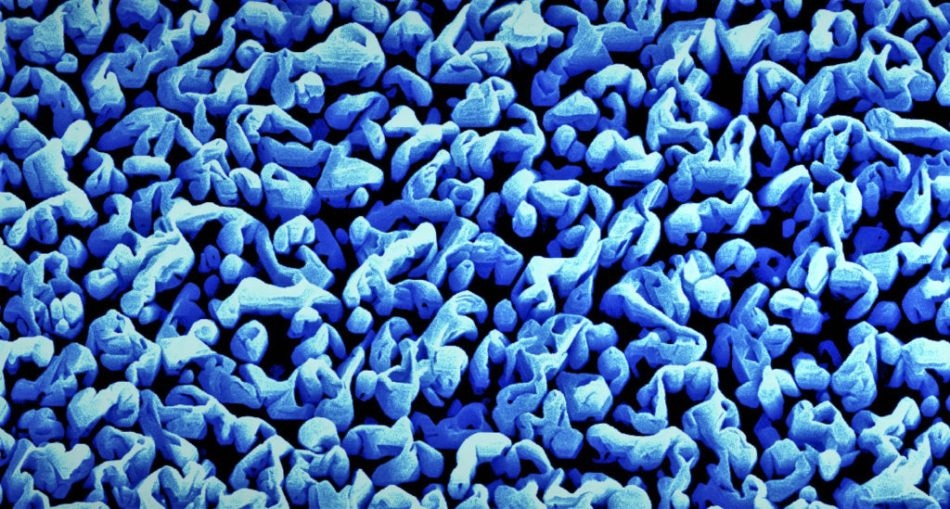May 4 2018
A recently developed stable artificial photosynthesis device is capable of doubling the efficiency of harnessing sunlight to break apart both salt and fresh water, producing hydrogen that can then be utilized in fuel cells.
 The colorized electron microscope image shows the gallium nitride towers of the artificial photosynthesis device at 25k magnification. These nanostructures rip water molecules apart into hydrogen and oxygen to produce clean hydrogen fuel. (Image credit: Faqrul A. Chowdhury, McGill University)
The colorized electron microscope image shows the gallium nitride towers of the artificial photosynthesis device at 25k magnification. These nanostructures rip water molecules apart into hydrogen and oxygen to produce clean hydrogen fuel. (Image credit: Faqrul A. Chowdhury, McGill University)
It is also possible to reconfigure the device to convert carbon dioxide back into fuel.
Hydrogen is the cleanest-burning fuel, with the only emission being water. However, hydrogen production is not environmentally friendly at all times. Conventional techniques require electrical power or natural gas. The technique advanced by the new device, known as direct solar water splitting, only uses light from the sun and water.
“If we can directly store solar energy as a chemical fuel, like what nature does with photosynthesis, we could solve a fundamental challenge of renewable energy,” said Zetian Mi, a professor of electrical and computer engineering at the University of Michigan who led the research while at McGill University in Montreal.
Faqrul Alam Chowdhury, a doctoral student in electrical and computer engineering at McGill, said the downside of solar cells is that they cannot store electricity without batteries, which have limited life and a high overall cost.
The device is built from the same extensively used materials as solar cells and other electronics, including silicon and gallium nitride (mostly found in LEDs). With an industry-ready design that works with merely seawater and sunlight, the device opens the door for mass production of clean hydrogen fuel.
Earlier direct solar water splitters have accomplished slightly more than 1% stable solar-to-hydrogen efficiency in saltwater or fresh water. Other methods suffer from the use of expensive, unstable, or inefficient materials, such as titanium dioxide, that also might involve incorporating extremely acidic solutions to attain higher efficiencies.
Mi and his team, however, attained over 3% solar-to-hydrogen efficiency. To reach this steady efficiency, the team constructed a nano-sized cityscape of gallium nitride towers that created an electric field. The gallium nitride converts light, or photons, into mobile electrons and positively charged vacancies known as holes. These free charges split water molecules into oxygen and hydrogen.
“When this specially engineered wafer is hit by photons, the electric field helps separate photogenerated electrons and holes to drive the production of hydrogen and oxygen molecules efficiently,” Chowdhury said.
Presently, the silicon backing of the chip does not add to its function, but it could be offering more. The subsequent step may be to use the silicon to help trap light and funnel charge carriers to the gallium nitride towers.
“Although the 3 percent efficiency might seem low when put in the context of the 40 years of research on this process, it’s actually a big breakthrough,” Mi said. “Natural photosynthesis, depending on how you calculate it, has an efficiency of about 0.6 percent.”
He adds that 5% efficiency is the first step for commercialization, but his team is focused on achieving 20 or 30% efficiency.
Mi is also involved in a similar research to strip carbon dioxide of its oxygen to convert the resulting carbon into hydrocarbons, such as syngas and methanol. This research path could possibly lead to the removal of carbon dioxide from the atmosphere, similar to what plants do.
“That’s the truly exciting part,” Mi said.
The device is documented in the research paper, “A photochemical diode artificial photosynthesis system for unassisted high efficiency overall pure water splitting,” published in Nature Communications. Besides Mi and Chowdhury, co-authors include Michel Trudeau of the Center of Excellence in Transportation Electrification and Energy Storage, Hydro-Québec, and Hong Guo of McGill University.
The study was supported by the Fuel Cell Technologies Office of the U.S. Department of Energy and Emissions Reduction Alberta.